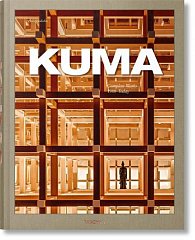From his Great (Bamboo) Wall house to the Japan National Stadium for the Tokyo Olympic Summer Games, originally planned for 2020, Japanese architect Kengo Kuma pioneered a truly sustainable approach to contemporary architecture, translating local craftsmanship and resources into a new tactile architecture. Discover the scope of his practice-defining oeuvre in this XXL monograph.Famous First Edition: First printing of 5,000 numbered copiesAlso available as an Art Edition with a custom-built wooden slipcase and accompanied by a photogravure of a sketch by Kengo Kuma, signed by the artist and limited to 200 copies.
Erasing architecture: a definitive survey of the architect’s oeuvre Famous First Edition: First printing of 5,000 numbered copies After Tadao Ando, Toyo Ito, and Fumihiko Maki, Kengo Kuma has breathed renewed vigor and lightness into Japanese architecture. Departing from the modernist skyscraper of the 20th century, Kuma traveled through his native Japan to develop a truly sustainable approach, translating local craftsmanship and resources into site-specific, timely buildings. Informed by tradition, and with both feet firmly planted in the present, this “materialist” heralds a new tactile architecture marked by its engaging surfaces, innovative structures, and fluid forms, reconnecting people with the physicality of a house. Kuma’s objective, above all else, is “just to respect the culture and environment of the place where I am working.” To this end, Kuma shaped the China Academy of Art’s Folk Art Museum partially from discarded roof tiles; created a Chapel out of birch and moss in Nagano; and worked with local craftsmen to sculpt the V&A Dundee into a twisted, layered reflection of the Scottish coastal cliffs. With an extraordinary sensitivity for space, light, and texture, Kuma reveals unexpected qualities in materials, finding the weightlessness of stone in Chokkura Plaza and the softness of aluminum in the thatched roof of the Yangcheng Lake Tourist Transportation Center. More recently, the architect brought his philosophy to the Japan National Stadium built for the Olympic Games, originally planned for 2020. Kuma has said the stadium could be “the catalyst that will transform Tokyo back from a concrete city. I want it to set an example that will help alter the direction of Japanese architectural design.” In this XXL-sized monograph with some 500 illustrations spanning photographs, sketches, and plans, Kuma guides us through his entire career to date, detailing milestone projects as well as ongoing works.Soon also available as an Art Edition with a custom-built wooden slipcase and accompanied by a photogravure of a sketch by Kengo Kuma, signed by the artist and limited to 200 copies.
The artist
Kengo Kuma (born in Yokohama in 1954) attended the University of Tokyo and established Spatial Design Studio in 1979 after further studies at Columbia University, New York. In 1987, he founded Kengo Kuma & Associates. He is based in Tokyo and Paris, while he teaches at the Graduate School of Architecture at the University of Tokyo, where he also runs his own Laboratory, Kuma Lab.
The editor
Philip Jodidio studied art history and economics at Harvard, and edited Connaissance des Arts for over 20 years. His TASCHEN books include the Architecture Now! series and monographs on Tadao Ando, Santiago Calatrava, Renzo Piano, Jean Nouvel, Shigeru Ban, Richard Meier, Zaha Hadid, and soon Norman Foster.
Kuma. Complete Works 1988–Today Kengo Kuma, Philip Jodidio Hardcover, printed on two different paper stocks, 30.8 x 39 cm, 4.97 kg, 460 pages ISBN 978-3-8365-7512-6Multilingual Edition: English, French, German




 Když teď objednám,
Když teď objednám, 

































